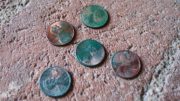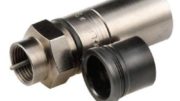I was looking at the “Understanding CEA Antenna Marks for Outdoor Antennas” page on the Solid Signal site, located here: Understanding CEA Antenna Marks for Indoor/Outdoor TV Antennas
when I read what seemed to me to be the statement that the only way to get the TV stations which are very far away is with a medium or large directional antenna with a pre-amp.
I found it a bit disconcerting to see what I thought was the opposite point of view from my own. My “point of view” is based on best engineering practices and was learned in college and is expressed in numerous articles on the subject, many of which are on the web today.
To try to clarify what CEA was recommending, I went to their web site to see what they were all about. I was also hoping to find an email address to see if I could talk to someone there about this recommendation. I found no contact information of the type I was looking for. I did find that the organization is the “Consumer Electronics Association,” which is made up of corporate members who are trying to sell stuff. It has nothing to do with the consumer end of things. Regular membership costs $850/year for companies doing $4 million or less and goes up from there. (Solid Signal is a member of the CEA.)
What I’m getting at is the possible point-of-view of the CEA. They are seller-centric not consumer-centric. By that, I mean they care about the people who are members – manufacturers/sellers – not the people buying, the consumers. So, everything they publish must be taken with that in mind.
That said, I’ve read and re-read the statements on the above mentioned “Understanding” page and have concluded that their big fault is perhaps only in not being clear enough about what they are trying to say. I’ll give them the benefit of the doubt. Perhaps I’m looking at their statements with too fine a focus.
Either way, this is a good place to start with a simplified look at the three things – gain, loss, and noise – which affect our enjoyment of what we receive. We need to have a working knowledge of these three things when it comes to putting up an antenna that will improve our TV (or radio) reception.
I’m not going to give you numbers and equations to work with. Those are available on the web for those interested in such things. I’ll try to explain this using simple logic and I hope that I’ll be able to make it clear enough for almost everyone to be able to use.
Anyone who thinks they can do better, please feel free to chime in and help out with your comments.
I think we all need to understand the following statements and take them as the truth where receiving radio or TV is concerned.
Radio/TV Truth Statement #1:
If there is not enough signal at the output of the antenna for the receiver (TV, radio) to use, then the only recourse is to buy or build a better antenna.
Radio/TV Truth Statement #2:
Everything we do – from the output of the antenna to the receiver – degrades the signal. In other words, we can only make things worse from this point on. There is no magic bullet, no way to make things better than they already are.
Radio/TV Truth Statement #3:
All Gain comes at a price.
- In the case of an antenna, the cost is the beam divergence. What stations can the antenna receive? Can it receive all stations no matter where they are on the compass, or can it only see those between 10 and 50 degrees from North? The higher the gain, the narrower the viewing angle is, or the smaller the beam divergence is. The cost is seeing fewer TV stations, and the antenna may then have to be able to rotate to see other stations.
- For an amplifier, the cost is in the noise figure of the amplifier. We can add gain with an amplifier, but the electronics add two types of noise – shot and thermal. You’ll have to look those up if you want to learn more about them. So, the cost of the amplifier is in added noise that tends to hide the desired signal if it is not strong enough to begin with.
We could go into the math at this point to prove these statements, but there are many web sites which have done this so I don’t have to. If you’re interested in the calculations, please look them up. Look for things such as Noise Figure (NF), Noise Margin Noise margin – Wikipedia, the free encyclopedia (NM), Signal to Noise Ratio (S/N), Amplifier gain, and Antenna gain.
TV Fool, on one of their pages, explains the term “Noise Margin” (NM). They say that if the NM is not better than 0 at the TV, then the station will not be able to be received. You have to add/subtract all the noise margins for everything in the path from the TV station to the TV. TV Fool supplies their best estimate of the NM for the TV signal to your antenna. You have to figure out the rest of the NMs for every other item in the path to the TV to see what you have when the signal arrives at the TV input.
See: TV Signal Analysis FAQ and search for “NM(dB)” and also read the explanation about the Noise Margin and see how/what to add/subtract to the NM to figure out if your signal is good enough to watch. This explanation is below the grid of items.
The one point I want to make here is the point that TV Fool makes in their further explanation of the noise margin: “If an antenna has a built-in amp, the extra gain from the amp SHOULD NOT be included as part of the antenna gain (this actually subtracts from the Noise Margin …)” You’ll have to go to their site to read it all if you want to know more.
The term noise margin (NM) is used in EE. I found a good definition on Wikipedia: “In electrical engineering, noise margin is the amount by which a signal exceeds the minimum amount for proper operation.” It also says that the term is used when talking about communications systems, TV, radio, etc., and in digital circuits when being able to distinguish between a one and a zero.
No matter which way we look at it – Noise Margin, Noise Figure, or Signal to Noise Ratio – the bottom line is the same. We need a certain level of signal, above the noise, for the receiver to be able to use the signal. For a TV, this means being able to view and hear the signal without it breaking up.
You may well ask then, “If there is no way to improve my signal with an amplifier, why should I ever buy one?”
There are very good reasons to buy an amplifier, and running the numbers for NF or NM will bring this out, but we don’t have to run the numbers to get a basic understanding. This all comes down to the Truth Statement #2. Everything we put between the antenna and the TV makes things worse. Everything will make the signal level lower or increase the noise.
Yes, I mean everything. Amplifier, coax, combiner, splitter, and even the connections/connectors.
Let’s go through two related cases.
Case 1: The antenna gets the station of interest at a rather low level. A TV hooked to the antenna with 1 foot of low loss coax shows a picture that pixilates, breaks up, or stops, due to the smallest change in conditions, a little rain, fog, etc.
Question: What can we do to improve the signal of this antenna so that the TV can use it without any problems?
Answer: Nothing. See Truth Statement #1 – At this point we need a better antenna, or a better antenna situation.
Real Life:
In one case I worked on, the TV stations desired went missing due to the leaves coming out on the trees between the antenna in the attic and the TV station. I took a portable TV up to the attic, and even with a very short piece of good quality coax, could not receive the station with the attic antenna. This antenna had a built-in amplifier.
I took the antenna down and removed the amplifier. I put the antenna back up and found that now the portable TV could get the TV stations desired. Truth Statement #3 – All gain comes at a price. The price in this case was the added noise figure of the poor amplifier. It was higher than the signal we had available. In this case, the cost, to the signal, of using this amplifier was too high and it had to be replaced.
Case 2: The antenna gets the TV signals wanted but they can’t be viewed on the TVs in the house 75 to 150 feet of coax away. This case is part two of Case #1. The antenna situation is now good but only in the attic when using only three feet of poor quality coax. After the coax to the splitter and then the coax runs to the TVs, there is not enough signal level to watch TV. However, every now and then at least one or two stations make a brief appearance at the closer TV when the splitter is not used.
More Real Life:
I noticed that the coax to the splitter was about 25 feet long and not of the best quality. I picked up two shorter pieces of better quality coax and a good quality amplifier. I then also shortened the coax from the splitter to the TVs since there was extra, unneeded, length of coax from the TVs at the splitter. I also installed better quality connectors.
Both TVs were then able to watch the stations wanted without any problems and they continue to do so years later.
Explanation: In case one, the pre-amp that came with the antenna was of a lower quality than needed. In other words, its noise figure was so high that it hid the signal that the antenna was able to receive so that the TV couldn’t use it. Without the amplifier, the signal was able to be seen sometimes at the closer TV, 75 feet of coax away, with no splitter being used just the coax from the antenna to TV. This told me that the levels coming out of the antenna were probably good enough for a good quality amplifier to increase the levels so that the splitter and longer coax run could also be used.
I found a good quality amplifier, better quality shorter pieces of coax, and improved the existing coax runs by removing the excess coax and using better connectors.
For the complete blow-by-blow of this case see To A Neighbor’s Rescue: Now She Can See Her DTV (A Primer on Digital Signal Reception…Part 1)Popular Communications, August 2011, p 12-19 – http://www.popular-communications.com/
To figure out if a situation will work, we need to think about it and sometimes experiment. If you’re into running the numbers, then you need to test what you have and then run the numbers to see if what can be gotten can improve the situation.
I’ve said this before, but it is always true and bears repeating – if there’s not enough signal coming out of the antenna, then no amount of amplification will get a signal to your TV that’s good enough to use. An amplifier is really the original “garbage in garbage out” device. Computers came later.
Until next time, good viewing!
Phil Karras, KE3FL





